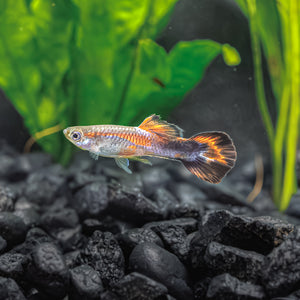Your Cart is Empty
FREE UPS 1-DAY SHIPPING ON ORDERS OVER $300!


The Purple Haze Guppy is a freshwater fish that stands out with its soft purple tones and hints of orange in its body. Its unique coloration makes it a popular choice for aquarists who want to add subtle yet noticeable color to their aquarium. This guppy is easy to care for and thrives in community tanks with other non-aggressive fish, making it a great option for both beginners and seasoned aquarists.
The Purple Haze Guppy is an active swimmer and prefers living in groups, which helps bring out its natural behaviors. Providing plants and open swimming areas will keep these guppies comfortable and healthy. Whether you’re looking to start a small guppy colony or enhance your tank’s diversity, the Purple Haze Guppy is a versatile and low-maintenance choice.
A 10-gallon tank is the minimum recommended size for keeping Purple Haze Guppies. However, a larger tank is better if you plan to keep a group or a community of fish. Guppies are active swimmers, so they need enough room to move around comfortably.
Yes, they are peaceful and do well in community tanks with other non-aggressive species. Suitable tankmates include tetras, rasboras, small Corydoras, and snails. Avoid keeping them with larger, aggressive fish that may nip at their fins.
Purple Haze Guppies are omnivores and thrive on a varied diet. A mix of high-quality flakes or pellets, supplemented with live or frozen foods like brine shrimp, daphnia, or bloodworms, ensures they receive proper nutrition. They also enjoy plant-based foods, such as blanched spinach or algae wafers.
It’s best to keep them in groups of at least 3-5. Guppies are social fish, and living in groups encourages more natural and active behavior. A general rule is to maintain a male-to-female ratio of 1:2 or 1:3 to reduce stress on females.
Yes, guppies are prolific livebearers, and Purple Haze Guppies are no exception. If males and females are kept together, they will likely breed without special intervention. If you want to raise fry, consider adding fine-leaf plants or a breeding box to protect the babies from being eaten by adult fish.
Healthy guppies are active, have vibrant coloration, and show no signs of clamped fins or lethargy. Watch for any signs of disease, such as white spots, ragged fins, or unusual swimming behavior. Regular maintenance and a balanced diet help keep them healthy.
No special care is required beyond standard aquarium maintenance. They need clean water, a balanced diet, and a stress-free environment with compatible tankmates. Adding live plants and keeping the tank free of sharp decorations will also enhance their quality of life.